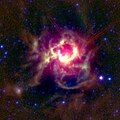NGC 1624
This article includes a list of general references, but it lacks sufficient corresponding inline citations. (November 2017) |
| NGC 1624 | |
|---|---|
 Image of NGC 1624 with the Isaac Newton Telescope Credit: IGAPS | |
| Observation data (J2000 epoch) | |
| Right ascension | 04h 40m 36.0s[1] |
| Declination | +50° 27′ 42″[1] |
| Distance | 20000 ± 2000 ly (6000 ± 600 pc[2]) |
| Apparent magnitude (V) | 11.8[1] |
| Physical characteristics | |
| Estimated age | <4 Myr[2] |
| Other designations | Cr 53, C 0436+503, OCl 403, Tribble Nebula |
| Associations | |
| Constellation | Perseus |
NGC 1624, also known as Sh2-212[3] in the Sharpless catalog, is a very young open cluster in the constellation Perseus inside an emission nebula. It was discovered by German-British astronomer William Herschel in 1790.[4] NGC 1624 is about 20,000 ly (6,000 pc) from Earth, and latest estimates give it an age of less than 4 million years.[2] Its apparent magnitude is 11.8,[1] and apparent diameter is about 3.0 arc minutes.[4] Its celestial location is right ascension (α) 04h 40m 36.0s and declination (δ) +50° 27′ 42″.[1] It is potentially an area of massive star formation.[5]
According to Robert Trumpler's classification of open clusters, this cluster contains fewer than 50 stars (letter p) with a high concentration (I) and whose magnitudes are distributed over an average interval (number 2). The letter n at the end (I2pn) means that the cluster is inside a nebula.
Along with nearby emission nebula Sh2-211[6] it makes up what has become known as the Tribble Nebulae,[7] so called because they look like the furry creatures first introduced in the Star Trek episode "The Trouble with Tribbles".
Gallery[edit]
-
The Tribble Nebula in Perseus, Sh2-211 and Sh2-212
-
NGC 1624 in mid-infrared with unWISE
References[edit]
- ^ a b c d e "NGC 1624". SIMBAD. Centre de données astronomiques de Strasbourg. Retrieved 9 November 2017.
- ^ a b c "Sejong Open Cluster Survey (SOS) - IV. The Young Open Clusters NGC 1624 and NGC 1931". SIMBAD. Centre de données astronomiques de Strasbourg.
- ^ "Sh2-212". Galaxy Map. Retrieved 16 November 2021.
- ^ a b Seligman, Courtney. "New General Catalogue objects: NGC 1600 - 1649". cseligman.com. Retrieved 9 November 2017.
- ^ Deharveng, L.; Lefloch, B.; Kurtz, S.; Nadeau, D.; Pomarès, M.; Caplan, J.; Zavagno, A. (2008). "Triggered massive-star formation on the borders of Galactic H II regions". Astronomy & Astrophysics. 482 (2): 585–596. arXiv:0803.4152. doi:10.1051/0004-6361:20079233. S2CID 16100087.
- ^ "Sh2-211". Galaxy Map. Retrieved 16 November 2021.
- ^ "Tribble Nebulae". Flickr. 15 November 2021. Retrieved 16 November 2021.
External links[edit]


